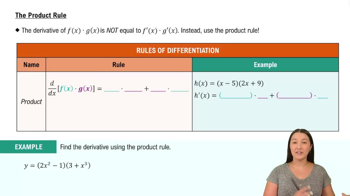Table of contents
- 0. Functions7h 52m
- Introduction to Functions16m
- Piecewise Functions10m
- Properties of Functions9m
- Common Functions1h 8m
- Transformations5m
- Combining Functions27m
- Exponent rules32m
- Exponential Functions28m
- Logarithmic Functions24m
- Properties of Logarithms34m
- Exponential & Logarithmic Equations35m
- Introduction to Trigonometric Functions38m
- Graphs of Trigonometric Functions44m
- Trigonometric Identities47m
- Inverse Trigonometric Functions48m
- 1. Limits and Continuity2h 2m
- 2. Intro to Derivatives1h 33m
- 3. Techniques of Differentiation3h 18m
- 4. Applications of Derivatives2h 38m
- 5. Graphical Applications of Derivatives6h 2m
- 6. Derivatives of Inverse, Exponential, & Logarithmic Functions2h 37m
- 7. Antiderivatives & Indefinite Integrals1h 26m
- 8. Definite Integrals4h 44m
- 9. Graphical Applications of Integrals2h 27m
- 10. Physics Applications of Integrals 2h 22m
3. Techniques of Differentiation
The Chain Rule
Problem 86
Textbook Question
Second derivatives Find d²y/dx² for the following functions.
y = x cos x²
 Verified step by step guidance
Verified step by step guidance1
First, identify the function y = x cos(x²). We need to find the second derivative d²y/dx².
Start by finding the first derivative dy/dx. Use the product rule, which states that if you have a function y = u*v, then dy/dx = u'v + uv'. Here, u = x and v = cos(x²).
Calculate the derivative of u = x, which is u' = 1. Then, calculate the derivative of v = cos(x²) using the chain rule. The chain rule states that if you have a composite function f(g(x)), then the derivative is f'(g(x)) * g'(x). Here, f(x) = cos(x) and g(x) = x², so v' = -sin(x²) * 2x.
Substitute u', v, u, and v' into the product rule formula: dy/dx = 1 * cos(x²) + x * (-sin(x²) * 2x). Simplify this expression to get the first derivative.
Now, find the second derivative d²y/dx² by differentiating the expression obtained for dy/dx. Apply the product rule and chain rule again as needed, and simplify the resulting expression to obtain d²y/dx².
 Verified video answer for a similar problem:
Verified video answer for a similar problem:This video solution was recommended by our tutors as helpful for the problem above
Video duration:
6mPlay a video:
Was this helpful?
Key Concepts
Here are the essential concepts you must grasp in order to answer the question correctly.
Second Derivative
The second derivative of a function measures the rate of change of the first derivative, providing information about the curvature of the function's graph. It is denoted as d²y/dx² and is essential for understanding the acceleration of the function's values. In practical terms, it helps identify concavity and points of inflection.
Recommended video:

The Second Derivative Test: Finding Local Extrema
Product Rule
The product rule is a fundamental differentiation technique used when finding the derivative of the product of two functions. It states that if u(x) and v(x) are functions, then the derivative of their product is given by d(uv)/dx = u'v + uv'. This rule is crucial for differentiating functions like y = x cos(x²), where two functions are multiplied.
Recommended video:

The Product Rule
Chain Rule
The chain rule is a method for differentiating composite functions, which are functions within functions. It states that if y = f(g(x)), then dy/dx = f'(g(x)) * g'(x). This rule is particularly important when dealing with functions like cos(x²), where the inner function x² requires differentiation to find the overall derivative.
Recommended video:

Intro to the Chain Rule

 5:02m
5:02mWatch next
Master Intro to the Chain Rule with a bite sized video explanation from Callie
Start learningRelated Videos
Related Practice






